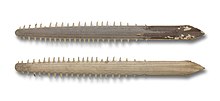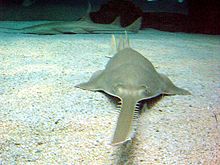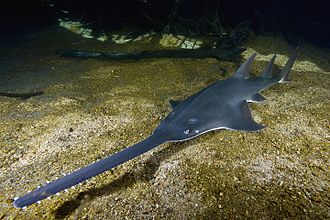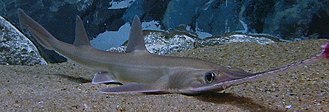Sawfish
This is the sighted version that was marked on May 25, 2021. There is 1 pending change that needs to be sighted.
![]()
Sawfish is a redirect to this article. For the type species, see common sawfish.
Sawfishes (Pristidae (Gr.: "pristis" = saw)), often also called sawfishes and to be distinguished from sawsharks, are rays that have a rather elongated, shark-like body. Their most striking feature is the "saw", a cartilaginous outgrowth of the head with teeth on the side, which can account for more than 25% of the fish's total length. The saw is used to catch prey. For this purpose, the animals swim into schools of fish and then strike back and forth with the saw in order to subsequently eat the injured victims. Furthermore, it is used to dig in muddy ground for molluscs and crustaceans. The saw also serves as a sensory organ for electromagnetic signals to detect prey.
Features
Sawfish rays are large rays and reach a length of 2.4 to 5, according to some reports even 6 to 8 meters when fully grown. Only Pristis clavata remains rather small at 1.40 meters. The body is slightly flattened and shark-like. The caudal peduncle is very strong, laterally flattened and has lateral keels. The transition from the body to the caudal peduncle is gradual. The body is covered with small placoid scales. Larger spines are not present on the top of the body or on the caudal peduncle. The head is flattened and bears the namesake "saw," a greatly elongated, flat rostrum that is set on either side with a row of sawtooth-like uniform teeth. The teeth sit in deep sockets and continue to grow, being replaced by regrowing ones as they are lost. The saw is primarily a sensory organ for detecting prey, and is also used to scare up food by poking at the ground or to immobilize or kill schooling fish by flailing wildly back and forth. The eyes on the top of the head are located far in front of the spiracles. On the underside of the head, there are five gill slits on each side at about the level of the middle of the pectoral-fin base. Gill rays are absent. The mouth on the underside of the head is transverse, straight, and without pits, folds, or similar features. The nostrils are located anterior to the mouth, are widely spaced, and are clearly separated from the mouth. The anterior nasal valves are short, unconnected, and also do not reach the mouth. The maxillary teeth are very small, round or oval in shape, and without any points. They sit in 60 or more rows in each jaw, are uniform and not plate-like.
The pectoral fins are relatively small compared to those of other rays and are not fused to the trunk to form a body disc. They attach to the posterior sides of the head behind the mouth and end well before the beginning of the ventral fin base. The ventral fins are triangular and not divided into two lobes. On the upper side are two large and equally sized dorsal fins, which may be sickle-shaped or triangular. They are widely separated: the first in front of or above the base of the pelvic fin, the second on the caudal peduncle. The caudal fin is large and resembles that of sharks. It is asymmetrical (heterocercous), with the spine running up the caudal fin and supporting the upper lobus. The lower lobus may be more or less well developed or absent altogether. Sawfishes are yellowish, brown, greenish, or grayish brown on the upper side, and the belly is whitish. Neither on the body nor on the fins are drawings or markings of any kind.
Sawfishes can only be confused with sawfishes (Pristiophoridae), which also have a saw-like rostrum. However, these tend to live in deeper marine regions and temperate latitudes. Their gill openings are located on the sides of the head and in front of the pectoral fin bases. Their body is less flattened, the saw teeth on the rostrum are smaller, and its underside is also studded with a row of small teeth. In the middle of the rostrum of the sawfish is found on the sides of a pair of long barbels.
| Comparison of sawfish and sawfish sharks | |||
| Features | Sawfish (Pristidae) | Sawfish sharks (Pristiophoridae) | |
| Gills: | ventral (underside of head) | lateral (head sides) | |
| Barbels: | no barbels | a pair of bartels in the middle of the saw | |
| Teeth on the side of the saw: | even | alternately small and large | |
| Habitat: | offshore shallow water | at greater depths of the shelf seas | |
| Size: | medium to large: 1.4 to 7.50 m | relatively small to medium size: 60 cm to 1.70 m | |

Upper and lower side of the rostrum of an Australian sawfish.

Pristis zijsron in the aquarium Genoa

Pristis pristis

Japanese sawfish
Occurrence
Sawfishes live in tropical areas of the Atlantic and Indo-Pacific near the coast. Five species live on the northern coast of Australia. Some species also enter brackish water zones and swim several hundred kilometres into the lower reaches of large rivers in Southeast Asia, New Guinea, Australia and the Amazon. Pristis microdon is known as the freshwater sawfish in Australia. Large populations of Pristis perotteti were known from Lake Nicaragua, where they were probably extirpated by commercial fishing in the 1970s. It was not until 2006 that sawfish and the bull shark (Carcharhinus leucas) were placed under protection in Nicaragua.
The common sawfish (Pristis pristis) also occurs in subtropical waters, e.g. in the western Mediterranean or in the cooler eastern Pacific from the Gulf of California to Ecuador.
Questions and Answers
Q: What are sawfish?
A: Sawfish are a family of rays that have a long body and a saw-like snout with teeth on either side.
Q: How do sawfish breathe?
A: Sawfish breathe through gill slits under their body and take in water through two spiracles behind the eyes when settling on the bottom.
Q: Do sawfish have enlarged pectoral fins?
A: Yes, sawfish have enlarged pectoral fins like those of a ray.
Q: What separates sawfish from other rays?
A: Sawfish are separated from other rays by their long, saw-like snout with teeth on either side.
Q: How big can sawfish grow?
A: Several species of sawfish can grow up to about 7 metres or 23 feet.
Q: What features do sawfish share with rays?
A: Sawfish share a mouth, nostrils, and gill slits under their body with rays.
Q: Why do sawfish take in water through spiracles when settling on the bottom?
A: Sawfish take in water through spiracles when settling on the bottom to get water to their gills without sand.
Search within the encyclopedia